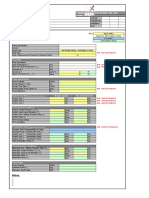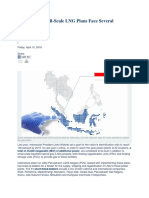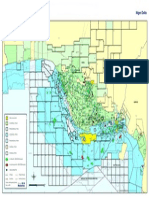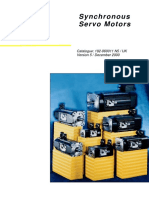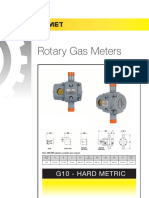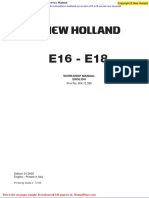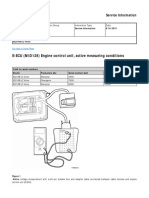Pressure - Vacuum Relief Valve - Part 1
Pressure - Vacuum Relief Valve - Part 1
Uploaded by
segunoyesCopyright:
Available Formats
Pressure - Vacuum Relief Valve - Part 1
Pressure - Vacuum Relief Valve - Part 1
Uploaded by
segunoyesOriginal Title
Copyright
Available Formats
Share this document
Did you find this document useful?
Is this content inappropriate?
Copyright:
Available Formats
Pressure - Vacuum Relief Valve - Part 1
Pressure - Vacuum Relief Valve - Part 1
Uploaded by
segunoyesCopyright:
Available Formats
10/26/13
Pressure / Vacuum Relief Valve - Part 1
safety relief valve
w w w .tanhov.com/relief_valve
relief valves made in China for safety applications.Cost-effective.
Home Valve Piping Components Piping layout Pipe fittings Forum
Piping Safety Vacuum Pressure Pressure Tank Water Valve
Pressure / Vacuum Relief Valve Part 1
By A JAD
Safety Relief Valves
www.be sa.it Be sa Ing. Santange lo S.p.A. Since 1946 - Milan - Italy
Table of contents: 1. Purpose of Pressure/Vacuum Relief Valves 2. How Pressure/Vacuum Relief Valves Function 3. Advantages of Pressure/Vacuum Relief Valve
Purpose of Pressure/Vacuum Relief Valve
In reality, properly sized opening on the tank roof protects the tank from rupture or imploading. However, it constantly outbreath and inbreath and during outbreathing cycle it losses the vapour to atmosphere and possesses constant fire hazard. This can be prevented by installation of pressure/vacuum relief valve. Cost of loss of vapour totally out weighs the cost of breather valve. a) Ly Ly = = Calculating the tank content loss during outbreathing 20 feet dia and above (TPY/1000) X (P/(14.7 P))68 D 1.73 H 0.51 T 0.50 FP
The outbreathing loss in barrels per year Turn overs per year The true vapour pressure at bulk liquid temperature in Lbs/in2 abs Tank diameter in feet The average outage in feet
TPY = P D H = = =
www.piping-engineering.com/pressure-vacuum-relief-valves-part-1.html
1/6
10/26/13
Pressure / Vacuum Relief Valve - Part 1
T FP Ly b)
= =
Average daily ambient temperature change Paint Factor Small dia tanks
(TPY/1000) X (P/(14.7-P)) 68
D 1.73 H 0.51 T 0.50 FP C
APIs estimated breathing loss table Breathing Loss Estimated losses Estimated losses with Pressure with open vent Relief Valve 30 x 40 42.5 x 40 60 x 30 100 x 40 5000 10,000 20,000 55,000 154 297 570 1382 235 441 825 2000 81 144 255 618 BBLS/Year saved using Pr Relief Valve
Tank Dia x Ht Nominal Tank in feet Capacity barrels
Due to the above statement breather valve is also termed as conservation vent valve. c) Basic fire protection mode with usage of pressure / vacuum relief valve
Observes close tank principle within set pressures on pressure and vacuum side hence vapours have no access to external fire source and to allow combustion Breather valve discharge to atmosphere is with positive pressure and the velocity of the relieving vapour is higher than flame speed hence protects the tank content from external fire source Over rich vapour mixture within tank due to equilibrium being reached in a closed tank, the vapours are too rich to burn. However when emptying the tank due to inbreathing of air and oxygen in air, the vapour mixture is susceptible to ignite hence flame arrestor shall be installed to protect the tank content In case of intermittent inbreathing the escapes of vapour from tank to atmosphere do not exist hence it is always in safe mode. d) e) Reduced corrosion They help in reduction in overall corrosion in a plant due to controlled emmision of vapour Recommendation
Pressure/vacuum valves are recommended by API 2000 for use on atmospheric storage tanks in which the hydrocarbon with a flash point below 100o F is stored. OSHA recommends that tank storing Class I liquids shall be equipped with venting device which shall be normally closed except over set pressure or vacuum conditions. Generally speaking the majority of the regulatory bodies dealing with tank safety such as API, NFPA, OSHA insurance
www.piping-engineering.com/pressure-vacuum-relief-valves-part-1.html 2/6
10/26/13
Pressure / Vacuum Relief Valve - Part 1
companies etc insist installations of these devices on flammable liquid storage tanks How Pressure/Vacuum Relief Valves Function
Fig 1- Operation Of Valve Under Pressure In Tank
Fig 2- Operation Of Valve Under Vacuum The atmospheric storage tanks are designed for storage of liquid hydrocarbon at operating conditions close to atmospheric pressure and temperature conditions. The tanks are designed in such a way to overcome the routine over pressure and vacuum conditions prevailing in a tank due to loading, unloading operation and thermal expansion and contraction of liquid due to change in ambient temperature during the day and in a year. These kinds of storage tanks are ideal and economical for storage of large quantity of liquid hydrocarbon and expensive chemicals in liquid form. These tanks are designed as per API 650 with conical reinforced roof with weak roof to shell design criteria and this is the criteria which imposes the restriction on over pressure and vacuum requirements beyond which the tank may rupture or implod and the main failure link is shell to roof joint. The normal range of design parameters for such tanks is (+) 150 MM WG & (-) 75 mm WG with respect to atmospheric pressure. The emissions of vapour from storage tanks is due to variations in vapour space within tank due to change in liquid level and variation in ambient temperature and its effect on wetted surface area of storage tanks. The breather valves are installed to reduce the continuous vapour loss to atmosphere through fixed vent nozzle to achieve the controlled losses with the set operating range of breather valve within the design pressure and vacuum parameters employed for the storage tanks. The saving in vapour loss is due to intermittent operation of breather valve. In order to accommodate large volumes at low set pressure these valves have ports that are greater in area compared to area of inlet port or nozzle provided on tank. The low setting values necessitates weight loading valve instead of spring loaded valve. Because of weight loaded concept a pressure / vacuum valve requires approx 100% overset pressure in order to reach full opening of the valve. However, while deciding on a set pressure the maximum allowable working pressure MAWP should be at least twice of the required set pressure to obtain optimum flow. If the MAWPis less than 100% above the required set pressure then the valve shall be larger in size than normally required. The possibility of valve chatter and accelerated seat and diaphragm wear will exist if less than 20% over pressure is allowed. A pressure / vacuum valve is not same as high pressure safety valve and should not be sized at 10% to 20% over pressure.
www.piping-engineering.com/pressure-vacuum-relief-valves-part-1.html 3/6
10/26/13
Pressure / Vacuum Relief Valve - Part 1
Advantages of Pressure/Vacuum Relief Valve (Evaporation Losses)
Saving in cost of content lost in form of vapour Protects tank from over pressure or vacuum condition Protection under fire hazard Atmospheric corrosion of area in vicinity Control the emissions to atmosphere
Fig-1 Pressure and Vacuum Relief Valve
Related Posts:
Types of Breather Valves Basic function of breather valve The breather valve also known as ... Pressure / Vacuum Relief Valve- Part 2 Sizing Of Pressure / Vacuum Relief Valves (AS PER API 2000) A) ... Steam Trap Selection: How to Calculate Condensate Loads As I mentioned in my earlier post regarding about Steam ... What is Pipe Schedule What is Pipe Schedule? As the main function of the pipes ... Designing Piping Systems? Must Know Codes and Standards Piping systems are generally designed based on codes and standards. ... Google+
Send
Leave a Reply
Add a comment...
Post to Facebook
Facebook social plugin
Posting as Olusegun Oyebanji (Change)
Com m ent
www.piping-engineering.com/pressure-vacuum-relief-valves-part-1.html
4/6
10/26/13
Pressure / Vacuum Relief Valve - Part 1
Search Knowledge Database
Search
By A Jad
We're on
Follow
+102
Find us on Facebook
Piping-engineering
Like 105 people like Piping-engineering.
Facebook social plugin
Or reach me on ajonlineweb@gmail.com
Subscribe Updates. It's Free!
Your email:
Enter email address... Subscribe
Google+ Recent Posts
Air Cooled Heat Exchanger
6:19 pm By Piping engineering
www.piping-engineering.com/pressure-vacuum-relief-valves-part-1.html 5/6
10/26/13
Pressure / Vacuum Relief Valve - Part 1
1.0 Introduction to Air Cooled Heat Exchanger This kind of heat exchanger are used in petrochemical and refineries to utilize the atmospheric air to cool the hydrocarbon, Read More
Cooling Tower: Heat Transfer Equipment in Process Industry
4:43 pm By Piping engineering 1.0 Introduction to Cooling Tower: Cooling Tower is the most common equipment/ facility in any Refinery, Petrochemical and Petroleum plants. Cooling towers are heat exchangers that are Read More
Column Piping: Study Layout, Nozzle Orientation & Platforms Requirements
10:39 am By Piping engineering 1.0 Sequence of Column Piping Study 1.1 All available information / data from Equipment specification and P&ID shall be written on the elevation view of the column Read More
Distillation Column Piping: Absorption Stripping, Fractionation
5:11 pm By Piping engineering 1.0 Introduction to Column Piping Study for the column piping should start after complete understanding of the following document: a) Technical specification of the column b) Read More
Thermal Insulation: Types, System and Standards
6:03 am By Piping engineering 1. Thermal Insulation Types: Based on the functional requirements, the Insulation Material is classified into 2 types as below Hot Insulation: Insulation used on hot surfaces Read More 2013 Piping engineering
www.piping-engineering.com/pressure-vacuum-relief-valves-part-1.html
6/6
You might also like
- Weighted Criteria Matrix: Value Option 1 Score Option 2 Score Option 3 Score Option 4 Score Prioritization CriteriaDocument3 pagesWeighted Criteria Matrix: Value Option 1 Score Option 2 Score Option 3 Score Option 4 Score Prioritization CriteriasegunoyesNo ratings yet
- Economic Analysis - MArginal FieldDocument20 pagesEconomic Analysis - MArginal FieldsegunoyesNo ratings yet
- Economic EvaluationDocument12 pagesEconomic EvaluationsegunoyesNo ratings yet
- Economic EvaluationDocument12 pagesEconomic EvaluationsegunoyesNo ratings yet
- Appraisal of Flexible Pipe Systems: Guidance Notes ForDocument27 pagesAppraisal of Flexible Pipe Systems: Guidance Notes ForsegunoyesNo ratings yet
- Investment Analysis of Marginal FieldsDocument39 pagesInvestment Analysis of Marginal FieldssegunoyesNo ratings yet
- XSize Pump CALCDocument7 pagesXSize Pump CALCsegunoyesNo ratings yet
- Offshore & Subsea Equipment ManufacturersDocument1 pageOffshore & Subsea Equipment ManufacturerssegunoyesNo ratings yet
- Gas Flaring NigeriaDocument36 pagesGas Flaring NigeriaSahar SohailNo ratings yet
- E & P November 2019 PDFDocument100 pagesE & P November 2019 PDFsegunoyesNo ratings yet
- Advantages and ChallengesDocument4 pagesAdvantages and ChallengessegunoyesNo ratings yet
- Map of Nigeria Oil FieldDocument1 pageMap of Nigeria Oil Fieldriddi12355% (11)
- Siemensoilandgas2016 LactunitDocument35 pagesSiemensoilandgas2016 LactunitsegunoyesNo ratings yet
- Environmental Associates Limited: A Summary of The Effluent TreatmentDocument11 pagesEnvironmental Associates Limited: A Summary of The Effluent TreatmentsegunoyesNo ratings yet
- Oil Processing PDFDocument65 pagesOil Processing PDFsegunoyesNo ratings yet
- API 14C TablesDocument10 pagesAPI 14C TablessegunoyesNo ratings yet
- Hidden Figures: The American Dream and the Untold Story of the Black Women Mathematicians Who Helped Win the Space RaceFrom EverandHidden Figures: The American Dream and the Untold Story of the Black Women Mathematicians Who Helped Win the Space RaceRating: 4 out of 5 stars4/5 (932)
- The Little Book of Hygge: Danish Secrets to Happy LivingFrom EverandThe Little Book of Hygge: Danish Secrets to Happy LivingRating: 3.5 out of 5 stars3.5/5 (424)
- The Yellow House: A Memoir (2019 National Book Award Winner)From EverandThe Yellow House: A Memoir (2019 National Book Award Winner)Rating: 4 out of 5 stars4/5 (99)
- The Subtle Art of Not Giving a F*ck: A Counterintuitive Approach to Living a Good LifeFrom EverandThe Subtle Art of Not Giving a F*ck: A Counterintuitive Approach to Living a Good LifeRating: 4 out of 5 stars4/5 (5973)
- The World Is Flat 3.0: A Brief History of the Twenty-first CenturyFrom EverandThe World Is Flat 3.0: A Brief History of the Twenty-first CenturyRating: 3.5 out of 5 stars3.5/5 (2272)
- Shoe Dog: A Memoir by the Creator of NikeFrom EverandShoe Dog: A Memoir by the Creator of NikeRating: 4.5 out of 5 stars4.5/5 (545)
- Elon Musk: Tesla, SpaceX, and the Quest for a Fantastic FutureFrom EverandElon Musk: Tesla, SpaceX, and the Quest for a Fantastic FutureRating: 4.5 out of 5 stars4.5/5 (476)
- Devil in the Grove: Thurgood Marshall, the Groveland Boys, and the Dawn of a New AmericaFrom EverandDevil in the Grove: Thurgood Marshall, the Groveland Boys, and the Dawn of a New AmericaRating: 4.5 out of 5 stars4.5/5 (270)
- A Heartbreaking Work Of Staggering Genius: A Memoir Based on a True StoryFrom EverandA Heartbreaking Work Of Staggering Genius: A Memoir Based on a True StoryRating: 3.5 out of 5 stars3.5/5 (232)
- Grit: The Power of Passion and PerseveranceFrom EverandGrit: The Power of Passion and PerseveranceRating: 4 out of 5 stars4/5 (619)
- Never Split the Difference: Negotiating As If Your Life Depended On ItFrom EverandNever Split the Difference: Negotiating As If Your Life Depended On ItRating: 4.5 out of 5 stars4.5/5 (893)
- The Emperor of All Maladies: A Biography of CancerFrom EverandThe Emperor of All Maladies: A Biography of CancerRating: 4.5 out of 5 stars4.5/5 (274)
- Team of Rivals: The Political Genius of Abraham LincolnFrom EverandTeam of Rivals: The Political Genius of Abraham LincolnRating: 4.5 out of 5 stars4.5/5 (235)
- The Hard Thing About Hard Things: Building a Business When There Are No Easy AnswersFrom EverandThe Hard Thing About Hard Things: Building a Business When There Are No Easy AnswersRating: 4.5 out of 5 stars4.5/5 (355)
- The Unwinding: An Inner History of the New AmericaFrom EverandThe Unwinding: An Inner History of the New AmericaRating: 4 out of 5 stars4/5 (45)
- On Fire: The (Burning) Case for a Green New DealFrom EverandOn Fire: The (Burning) Case for a Green New DealRating: 4 out of 5 stars4/5 (75)
- The Gifts of Imperfection: Let Go of Who You Think You're Supposed to Be and Embrace Who You AreFrom EverandThe Gifts of Imperfection: Let Go of Who You Think You're Supposed to Be and Embrace Who You AreRating: 4 out of 5 stars4/5 (1110)
- The Sympathizer: A Novel (Pulitzer Prize for Fiction)From EverandThe Sympathizer: A Novel (Pulitzer Prize for Fiction)Rating: 4.5 out of 5 stars4.5/5 (124)
- Her Body and Other Parties: StoriesFrom EverandHer Body and Other Parties: StoriesRating: 4 out of 5 stars4/5 (831)
- TDS-Flaw Crack Detector SystemDocument2 pagesTDS-Flaw Crack Detector SystemAaron PerezNo ratings yet
- Karabeyoglu 2005 TankPressDocument25 pagesKarabeyoglu 2005 TankPressmuttangi sushmaNo ratings yet
- Parker Motori PDFDocument32 pagesParker Motori PDFpredragstojicicNo ratings yet
- Frequently Asked Questions For Students Loan ApplicationsDocument2 pagesFrequently Asked Questions For Students Loan ApplicationsThe Campus TimesNo ratings yet
- Lead Construction Sweat Tea Design NewDocument14 pagesLead Construction Sweat Tea Design NewsobhiNo ratings yet
- Design Coaching 2 PDFDocument12 pagesDesign Coaching 2 PDFandre villanuevaNo ratings yet
- Pile Foundation Drawing of DLC - Uri en Near Brar SQR NR CB SR Sec SCHDocument9 pagesPile Foundation Drawing of DLC - Uri en Near Brar SQR NR CB SR Sec SCHPankaj SherwalNo ratings yet
- Flow Past A Cylinder: Created in COMSOL Multiphysics 5.6Document12 pagesFlow Past A Cylinder: Created in COMSOL Multiphysics 5.6massomieNo ratings yet
- Kobelco Crawler Crane Ck1200 1f Cke1100 1f Shop Manual S5gk00004ze03Document20 pagesKobelco Crawler Crane Ck1200 1f Cke1100 1f Shop Manual S5gk00004ze03scott100% (37)
- Rotary Gas Meters: G10 - Hard MetricDocument2 pagesRotary Gas Meters: G10 - Hard MetricSanny HamdaniNo ratings yet
- Corbel RainaDocument13 pagesCorbel RainaMadhurimaMitra100% (1)
- Construma Consultancy Pvt. LTD.: Design of Substructure and Foundation at P21Document23 pagesConstruma Consultancy Pvt. LTD.: Design of Substructure and Foundation at P21Venkat PalliNo ratings yet
- New Holland Excavator E16 E18 en Service ManualDocument20 pagesNew Holland Excavator E16 E18 en Service Manualthomas100% (61)
- 1 PB PDFDocument9 pages1 PB PDFDIEGO ALEJANDRO PARRA GARRIDONo ratings yet
- 02 SAMSS 011 FlangesDocument30 pages02 SAMSS 011 FlangesALI100% (2)
- June 2014 (R) MA - M1 EdexcelDocument9 pagesJune 2014 (R) MA - M1 EdexcelKollol KolllolNo ratings yet
- Pulse Detonation Engine Full ReportDocument4 pagesPulse Detonation Engine Full ReportShahil ChatholilNo ratings yet
- Industrial Training Report ModifyDocument140 pagesIndustrial Training Report ModifyGautamNo ratings yet
- JISKOOT 710 Electric Sampler Rev 5Document20 pagesJISKOOT 710 Electric Sampler Rev 5rendi saputroNo ratings yet
- RollersDocument15 pagesRollersRohith ChNo ratings yet
- Mill Reject SystemDocument22 pagesMill Reject Systemgangatharan100% (1)
- E-ECU MID128 Engine Control Unit, Active Measuring ConditionsDocument5 pagesE-ECU MID128 Engine Control Unit, Active Measuring Conditionsrohman100% (1)
- Art Am SeuDocument5 pagesArt Am SeuDayana AriasNo ratings yet
- C5-A Copper Based Anti-Seize StickDocument2 pagesC5-A Copper Based Anti-Seize Stickmahmouddiaa554No ratings yet
- HPC Shroud & VSV System ImprovementsDocument15 pagesHPC Shroud & VSV System Improvementsali100% (2)
- Engine Performance - Test - Engine Speed: Testing and AdjustingDocument2 pagesEngine Performance - Test - Engine Speed: Testing and AdjustingDANIEL VARGAS RODRIGUEZ100% (1)
- Strengthening Methods: Introduction To Strengthening Strengthening Mechanisms Strengthening of ColumnsDocument20 pagesStrengthening Methods: Introduction To Strengthening Strengthening Mechanisms Strengthening of Columnsbra22222No ratings yet
- DHH CompressorDocument10 pagesDHH CompressorEric J Jackson SanchezNo ratings yet
- Chapter 2 Dynamic Force AnalysisDocument22 pagesChapter 2 Dynamic Force AnalysissreeshpsNo ratings yet





